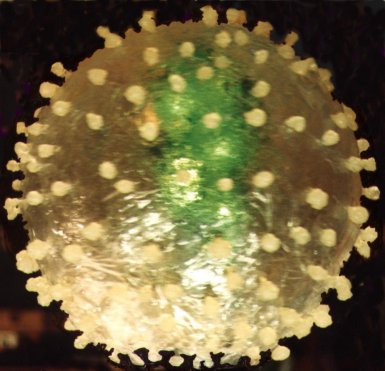The examination of the genetic composition of the virus revealed that a vaccine based on the most primitive strain would be better
Dr. Noah Brosh

Direct link to this page: https://www.hayadan.org.il/aids110703.html
Two studies dealing with the history of AIDS have appeared in scientific journals in recent weeks. In one, published in the "Science" weekly, it was announced that the source of the HIV virus, the cause of the disease (human AIDS), is in a chimpanzee's nest, which bit or devoured two other monkeys - a white-nosed goon and a red-capped moppet - each of whom carried a strain
another of the simian immunodeficiency virus (SIV). But in the body of the carnivorous chimpanzee, the two strains underwent a genetic change (mutation), and became a third monkey species that passed on to humans - after the infected chimpanzee's hive was bitten by a hunter in West Africa, probably sometime between 1910 and 1950.
But the journal "Journal of Virology", which deals with the study of viruses, has now presented a historical trajectory of the human AIDS (HIV) in the USA, based on genetic research in the patients' blood - and canceled a theory, which was prevalent until now, according to which the disease reached the USA By a flight attendant who worked for the Canadian airline, and infected homosexual couples.
The new study points to the possibility that the infection occurred many times and in different places and at different times and that AIDS came to the US with tourists from Haiti.
The similarity found between the modern strains of the AIDS virus, and its first strains, indicates that a vaccine - when developed - will be more effective if it is based on the initial strain of the virus. That is, the one that passed from chimpanzees to humans.
It is not yet clear whether the wounded hunter theory is well founded. It is even possible that the first humans who got sick were infected when they ate the game meat of an infected monkey.
The initial strain of the human virus was called HIV-1. It spread all over the world. The most common subtype in the US is different: HIV-1B. Whereas the HIV-2 strain is especially common in West Africa.
The reconstruction of the historical course of the plague by HIV-1B was done through genetic analysis of the patients' blood, including samples collected in the 80s, from the first patients identified.
The genetic composition of the virus was used for a comparative study. The structure of today's viruses has been compared with that of the "ancients". The study examined how quickly the virus changes - and how it spread. The results obtained confirm the hypothesis that the virus reached the USA in approximately 1968 (plus or minus a year). The first reports of the outbreak of the disease were in 1981 - and this period of time corresponds to the assumption that the incubation period of the virus in the carrier, until the disease manifests itself, is about ten years.
Another product of the study: calculation of the infection rate. It turns out that in the first years of the epidemic, the patient population doubled every year. In one decade, the number of patients increased almost 10,000 times (!). From the data collected for this study, it was not possible to derive the rate of infection growth from the mid-80s onwards. The importance of the research lies in its originality and also in the fact that it pointed to the great proximity of the modern types of AIDS to the "primary" AIDS. This may help the developers of vaccines against the disease.
The concentration of medical experts
https://www.hayadan.org.il/BuildaGate4/general2/data_card.php?Cat=~~~576001620~~~165&SiteName=hayadan
